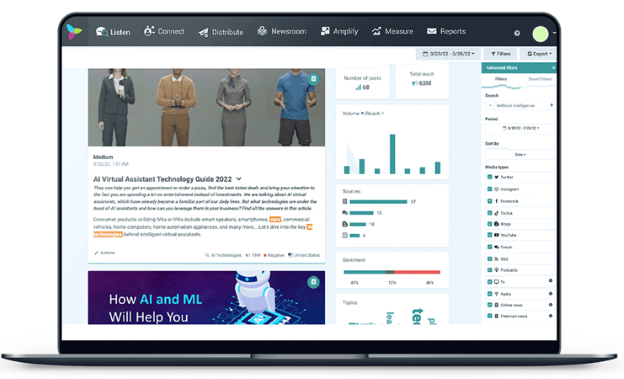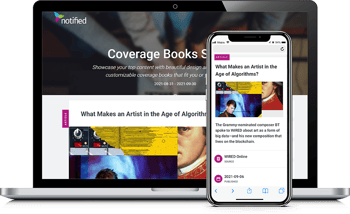Share this
Measuring PR Success: How Media Monitoring Can Help Quantify Your Impact
by Emily Newman on Feb 7, 2023 3:21:00 PM
As communicators’ roles become more challenging, new tools are helping public relations pros reinvent how they work and measure performance.
When evaluating PR campaigns, one of the most common complaints from the C-suite is how difficult it is to assess return on investment (ROI). This leads to the question: how can you justify PR campaign expenses to executives?
Media monitoring tools offer a way for PR pros to compile results and measure the success of their campaigns. In this blog, we'll share how you can quantify your PR impact with the help of media monitoring and better report on the success of your communications.
How to Measure PR Data: Where to Start?
During the planning phase, it’s critical to understand the “what,” “how” and “why” of your PR campaign. Knowing these answers will ensure everyone understands the goals and objectives – from the working level to the C-suite.
To effectively structure and measure tangible key performance indicators (KPIs), start your planning by answering the following questions:
-
What are you trying to convey with your PR strategy?
- What are the key messages?
- Do you want behaviors to change?
-
What will be evaluated in your PR campaign?
- Number of articles/mentions?
- Number of spokesperson quotes?
- Message pull through?
- Outside endorsement?
-
How will you compile your PR results?
- Clipping tools?
- Media monitoring and measurement software?
Next, consider how exactly you will conduct, measure and evaluate the following:
-
Message exposure
-
Audience review
-
Impact analysis

Get real-time social listening and media monitoring in the Notified PR Platform.
From here, you can identify which publications or influencers covered your campaign to understand an audience’s awareness, comprehension and retention of key messages.
The final step is to measure the impact of your campaign by looking at changes in attitudes, behaviors and opinions since its launch.
What Does Effective Media Monitoring Look Like?
The collection, review and interpretation of data from PR campaigns used to be a time-consuming, complicated and expensive process.
Thankfully, with the rise of PR software, the monitoring and social listening tools available today have changed the game. PR pros now have access to resources that showcase achievements through data measurement.
Effective media monitoring tools help you collect, read and analyze data from traditional publications and social platforms in real time—without having to log into multiple platforms.
How can you use media monitoring to strengthen your campaigns? Check out these 5 best practices:
1. Cast a Wide Net
Top-tier media outlets and Twitter aren’t the only channels that matter when it comes to an efficient media monitoring strategy. New bloggers, journalists and publications – even social media networks (i.e. TikTok) – come about often.
Along with their arrival, so do new and important audiences. Did you know that TikTok has over one billion active monthly global users? Use the knowledge gained from these new sources to build more targeted content that will resonate with audiences within their respective communities.
Wherever conversations are taking place, there is an opportunity for you. Monitoring mentions of your brand can uncover valuable insights about customer needs and preferences.
It’s critical to pay attention to the topics adjacent to your organization. Tracking your competitors and industry segments will reveal threats, open new opportunities with consumers, inform your product roadmap and future campaign success.
2. Benchmark, Benchmark, Benchmark
Benchmarking your PR content performance through monitoring will give you a unique perspective vs. the competition. These insights will allow you to establish success criteria, best practices and opportunities for improvement.
Focus on specific time periods and trends to see how your audiences interacted with competitor products, industry trends and your owned content. Listen to what the media is saying and predicting to help inform your communications strategy.
3. Automate Your PR Workflow
Manually listening and reporting data takes an abundance of time. As a result, the monitoring industry has rapidly grown through the discovery of incredible technology and services.
No matter if you’re a marketer, PR or communications professional, sales manager or customer support representative, what’s said online and how your company reacts will reflect upon your brand and, potentially, even your industry.
Email alerts and reports are a great way to streamline any monitoring workflow. You can create automated reports with the right technology or reporting partner.
Peak or volume threshold alerts will keep you updated with any trending content, potential crises, or any other topic with increased volumes. Real-time alerts automatically notify you of any outlets or social authors mentioning important topics. Scheduled alerts and daily coverage reporting will save time and are vital in your internal and external communications.
Customized Coverage Books
Showcase media coverage and owned content with branded design.

Learn More →
4. Support Other Departments
Each organization is different, and success criteria will change throughout the year. It’s vital to stay informed on what different teams expect in your reporting. Your daily coverage needs to remain relevant for your analysis to be accurate.
EXAMPLE: For those speaking negatively about your brand online, what are they saying? Are their conversations similar? Is there a service issue? Use this information to inform your customer support teams to build more proactive strategies.
Your competitors are also going to change their strategies from time to time. Keep a close eye on what they are doing and use that content with your sales team. Identify and pounce on new opportunities and build on the momentum generated by your industry.
5. Be Agile
As your audience moves into new topics and trends, you need to understand how to interact with them and constantly revise your outbound strategy. Whether you just completed a campaign, product launch or a successful conference, use these events as opportunities to review your process and overall PR or marketing plan.
Work closely with your media monitoring partner to ensure that the services and technologies are at their full potential. If you are utilizing alerts or technology, watch for new hashtags and keywords that may affect your content strategy.
Product Demo: Notified PR Platform
Simplify your PR communications and make life easier.

Watch Now →
Learn More About the Notified PR Platform
Notified’s media monitoring tools can help improve your communications by monitoring and reacting to what media and influencers are saying about your company or brand.
We can also provide custom reports outlining your campaign’s media exposure, potential reach, engagement and sentiment.
To learn more about how Notified can help you quantify the impact of your PR campaigns across all traditional and social platforms, with just one login, request a demo today.
Share this
- Public Relations (87)
- Press Releases (52)
- GlobeNewswire (50)
- Press Release Distribution (45)
- Artificial Intelligence (39)
- PR Communications (37)
- Investor Relations (35)
- Global News Distribution (20)
- Notified PR Platform (20)
- Experiences (17)
- Studio Webinar Platform (17)
- Virtual Events (17)
- IR Webcasts (16)
- IR Websites (16)
- Webcasts (16)
- Media Relations (14)
- Earnings Calls (13)
- Event Technology (12)
- Media Contacts Database (12)
- Webinar Strategy (12)
- Generative AI (11)
- Media Monitoring (11)
- ESG (9)
- Investor Days (9)
- Social Media (9)
- Virtual Event Platform (9)
- PR Measurement (8)
- Webinar (8)
- Earnings Release (6)
- IR Event Platform (6)
- Social Listening (6)
- News Roundup (5)
- Newswire (5)
- Video (5)
- Webinar Engagement (5)
- Earnings Day (4)
- IR Communications (4)
- SEO (3)
- Accessibility (2)
- DEI (2)
- Demand Generation (2)
- Journalism (2)
- Sentiment Analysis (2)
- Webhosting (2)
- Awards (1)
- Customer Experience (1)
- Emojis (1)
- Events (1)
- Insights & Analytics (1)
- Internships (1)
- Life At Notified (1)
- Mark Cuban Foundation AI Bootcamp (1)
- News Releases (1)
- PR Trends (1)
- Product Launch (1)
- ROI (1)
- Regulatory Filing (1)
- Retail Investors (1)
- SXSW (1)
- Share of Voice (1)
- Sponsorships (1)
- Success Story (1)
- eBook (1)
